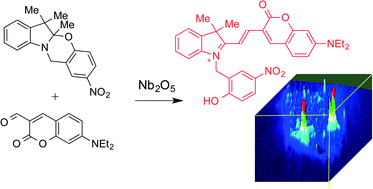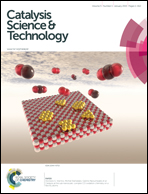Mechanistic insights into the Nb2O5 and niobium phosphate catalyzed in situ condensation of a fluorescent halochromic assembly†
Abstract
Solid niobium oxides (Nb2O5·nH2O) and niobium phosphate were used as heterogeneous acid catalysts to promote the condensation between a switchable oxazine and a fluorescent coumarin in an aprotic solvent. The catalysts were found to promote the generation of an active methylene from the enamine-based portion of the oxazine, which was followed by a nucleophilic attack on the aldehyde functionality of the coumarin reagent. In the resulting system, the emission of the conjugated fluorophore can be observed at 670 nm and, thus, the processes occurring at the catalyst surface can be monitored in real time by total internal reflection fluorescence microscopy (TIRFM).


 Please wait while we load your content...
Please wait while we load your content...